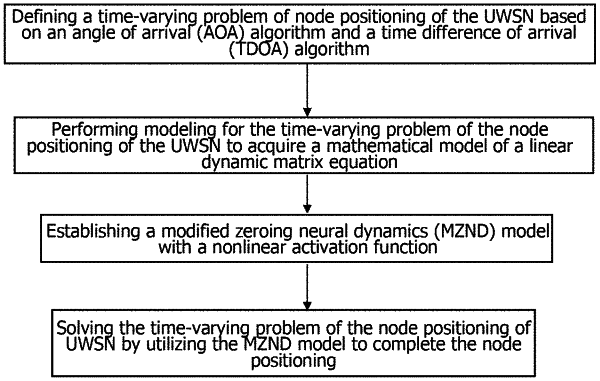| CPC H04B 13/02 (2013.01) [H04B 7/00 (2013.01); H04W 84/18 (2013.01)] | 3 Claims |

|
1. A node positioning method for an underwater wireless sensor network (UWSN) based on zeroing neural dynamics (ZND), comprising:
(S1) defining a time-varying problem of node positioning in the UWSN based on an angle of arrival (AOA) algorithm and a time difference of arrival (TDOA) algorithm;
(S2) performing modeling for the time-varying problem of the node positioning of the UWSN to acquire a mathematical model of a linear dynamic matrix equation;
(S3) establishing a modified zeroing neural dynamics (MZND) model with a nonlinear activation function; and
(S4) solving the time-varying problem of the node positioning of the UWSN by utilizing the MZND model to complete node positioning of the UWSN;
in the AOA algorithm, a position coordinate of an unknown node is obtained by an AOA of a communication signal at a receiving node, wherein the receiving node is an anchor node; consider a two-dimensional (2D) scenario where the position coordinate of the unknown node changes over time, and m anchor nodes are randomly arranged and have a fixed location, coordinates H of the m anchor nodes and position coordinate h(t) of the unknown node are respectively defined as follows:
 according to geometric meaning of AOA, a tangent (tan) value of an AOA of each of the m anchor nodes and the unknown node is represented as:
 wherein i ∈ {1, 2, . . . , m}; αi(t) denotes an arrival angle of a communication signal between the unknown node and an ith anchor node at moment t; and formula (1) is transformed into:
−tan(αi(t))x(t)+y(t)=yi−xi tan(αi(t)); and
the time-varying problem of the node positioning of the UWSN based on the AOA in the 2D scenario is defined as:
 the TDOA algorithm is configured to measure time differences of communication signals originated from a source to the m anchor nodes to estimate the position coordinate of the unknown node; a 3D mobile scenario is observed, wherein coordinates N of the m anchor nodes and position coordinate n(t) of the unknown node are respectively defined as follows:
 according to physical meaning of TDOA, the following formulas are obtained:
ri(t)=vTi(t)=√(xi−x(t))2+(yi−y(t))2+(z1−z(t))2;
ΔTi1(t)=Ti(t)−T1(t); and
ri1(t)=vΔTi1(t)=ri(t)−r1(t);
wherein i ∈ {1, 2, . . . , m}; v represents a transmission velocity of the communication signal in a media; Ti(t) represents time spent in transmitting the communication signal from the unknown node to the ith anchor node; ΔTi1(t) represents different between Ti(t) and time spent in transmitting the communication signal from the unknown node to a 1st anchor node; ri(t) represents a distance between the unknown node and the ith anchor node; ri1(t) represents different between ri(t) and a distance between the unknown node and the 1st anchor node; and by derivation, the time-varying problem of the node positioning of the UWSN based on the TDOA in the 3D mobile scenario is defined as:
 Wherein, Qi=xi2+yi2+zi2, xi1=xi−x1, yi1=yi−y1, zi1=zi−z1.
|